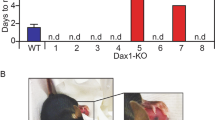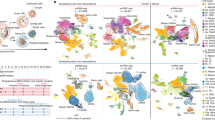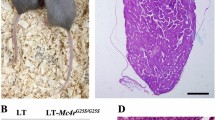Abstract
The sexual phenotype of an adult mammal depends on whether the fetal gonad has differentiated as a testis or as an ovary. Because individuals of XY or XXY sex chromosome constitution develop as males, while XX and X0 individuals develop as females, the presence of a Y chromosome seems normally to be required for testis differentiation and its absence to be necessary for differentiation of an ovary. The nature of the hypothetical Y-dependent substance responsible for masculinization of the indifferent gonad has been a matter for debate. A male-specific transplantation antigen, H–Y, has been known for many years1,2, and more recently a serologically detected antigen, also male-specific, has been reported3. Those who believe that the two are antigenically distinct4,5 refer to the latter as SDM (serologically detected male) antigen, but many refer to both as H–Y antigen6–8. The hypothesis9 that H–Y is itself the Y-dependent testis inducer, although supported by little or no direct evidence4,10, is economical and hence attractive. H–Y antigen is frequently stated to be the substance responsible for primary sex determination (for example, see ref. 11). We report here that H–Y is absent from certain mice that develop testes and are of indisputably male phenotype, hence this transplantation antigen is unlikely to be responsible for testis determination
This is a preview of subscription content, access via your institution
Access options
Subscribe to this journal
Receive 51 print issues and online access
$199.00 per year
only $3.90 per issue
Buy this article
- Purchase on Springer Link
- Instant access to full article PDF
Prices may be subject to local taxes which are calculated during checkout
Similar content being viewed by others
References
Eichwald, A. J. & Silmser, C. R. Transplantn Bull. 2, 148–149 (1955).
Simpson, E. Proc. R. Soc. B220, 31–46 (1983).
Goldberg, E., Boyse, E. A., Scheid, M. & Bennett, D. Nature new Biol. 238, 55–56 (1972).
Silvers, W. K., Gasser, D. L. & Eicher, E. M. Cell 28, 439–440 (1982).
Simpson, E., McLaren, A. & Chandler, P. Immunogenetics 15, 609–614 (1982).
Müller, U. & Schinder, H. Differentiation 23 (Suppl.), S99–S103 (1983).
Wachtel, S. S. H – Y Antigen and the Biology of Sex Determination (Grune & Stratton, New York, 1983).
Adinolfi, M., Polani, P. & Zenthon, J. Hum. Genet. 61, 1–2 (1982).
Wachtel, S. S., Ohno, S., Koo, G. C. & Boyse, E. A. Nature 257, 235–236 (1975).
Stewart, A. D. in Development in Mammals Vol. 5 (ed. Johnson, M. H.) 321–367 (Eisevier, Amsterdam, 1983).
Habel, A. Aids to Paediatrics (Churchill-Livingstone, Edinburgh, 1982).
Cattanach, B. M., Pollard, C. E. & Hawkes, S. G. Cytogenetics 10, 318–337 (1971).
McLaren, A. Differentiation 23 (Suppl.), S93–S98 (1983).
Singh, L. & Jones, K. W. Cell 28, 205–216 (1982).
Evans, E. P., Burtenshaw, M. & Cattanach, B. M. Nature 300, 443–445 (1982).
Burgoyne, P. S. Hum. Genet. 61, 85–90 (1982).
Eicher, E. M. in Prospects for Sexing Mammalian Sperm (eds Amann, R. P. & Seidel, G. E.) 121–135 (Colorado Associated University Press, 1983).
Hansmann, I. Cell 30, 331–332 (1982).
McLaren, A. & Monk, M. Nature 300, 446–448 (1982).
Cattanach, B. M., Evans, E. P., Burtenshaw, M. & Barlow, J. Nature 300, 445–446 (1982).
Bennett, D. et al. Nature 265, 255–257 (1977).
Simpson, E., Edwards, P., Wachtel, S., McLaren, A. & Chandler, P. Immunogenetics 13, 355–358 (1981).
Simpson, E., McLaren, A., Chandler, P. & Tomonari, K. Transplantation 37, 17–21 (1984).
Melvold, R. W., Koln, H. I., Yerganian, G. & Fawcett, D. W. Immunogenetics 5, 33–41 (1977).
Simpson, E., Chandler, P., Washburn, L. L., Bunker, H. P. & Eicher, E. M. Differentiation 23 (Suppl.), S116–S120 (1983).
Johnson, L. L., Sargeant, E. C., Washburn, L. L. & Eicher, E. M. Dev. Genet. 3, 247–254 (1983).
Singh, L., Phillips, C. & Jones, K. W. Cell 36, 111–120 (1984).
Tomonari, K. J. Immun. 131, 1641–1645 (1983).
Author information
Authors and Affiliations
Rights and permissions
About this article
Cite this article
McLaren, A., Simpson, E., Tomonari, K. et al. Male sexual differentiation in mice lacking H–Y antigen. Nature 312, 552–555 (1984). https://doi.org/10.1038/312552a0
Received:
Accepted:
Issue Date:
DOI: https://doi.org/10.1038/312552a0
This article is cited by
-
The role of human and mouse Y chromosome genes in male infertility
Journal of Endocrinological Investigation (2000)
-
Geschlechtsdetermination und Entwicklung der Genitalorgane
Der Urologe B (1997)
-
An H–YDb epitope is encoded by a novel mouse Y chromosome gene
Nature Genetics (1996)
-
Gene sequence and evolutionary conservation of human SMCY
Nature Genetics (1996)
-
Molecular basis governing primary sex in mammals
Japanese Journal of Human Genetics (1996)
Comments
By submitting a comment you agree to abide by our Terms and Community Guidelines. If you find something abusive or that does not comply with our terms or guidelines please flag it as inappropriate.



